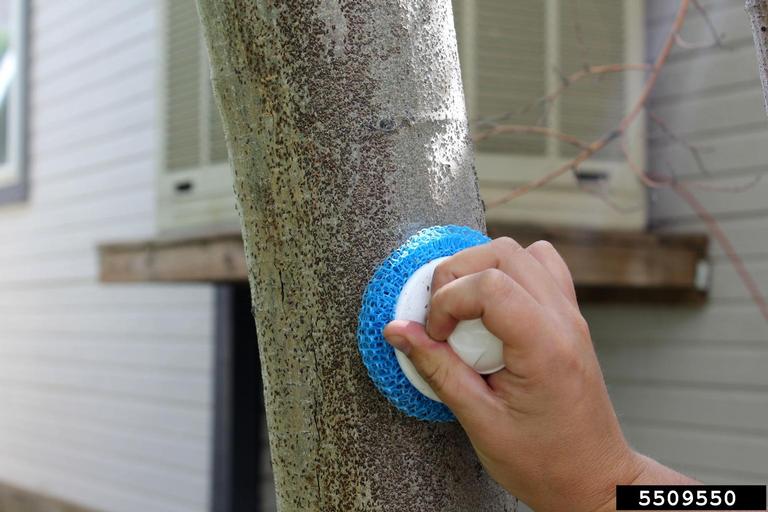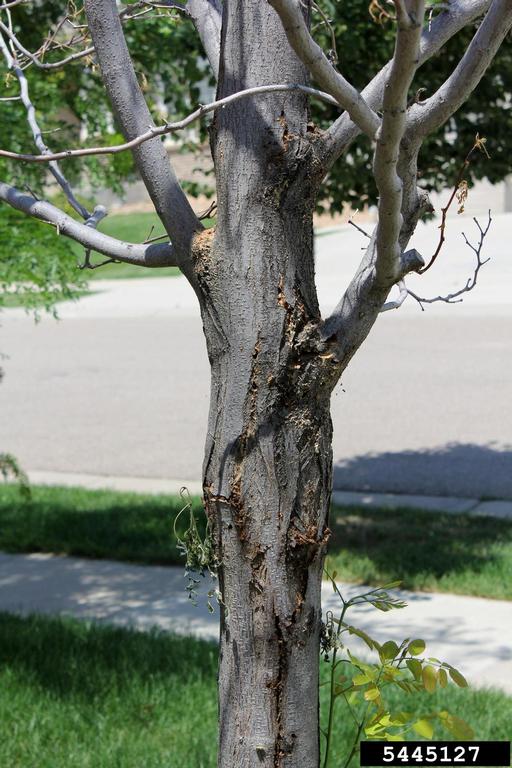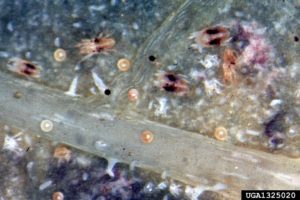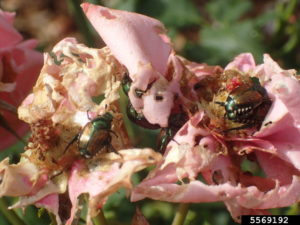
Over the past year many homeowners have given increased attention to their yards and gardens. Their awareness has also increased about the kinds of bugs that frequent their plantings including pollinators, insect natural enemies, and those feeding on and damaging plants. The following four insects are among the top troublemakers.
Spider Mites
Characteristics: among the smallest of the garden pests
Risk: Outbreaks often occur when susceptible plants are placed in hot, dry sites that create stress.
Controls: Improve the growing conditions of affected plants, such as providing adequate water or using water-conserving mulches. If treating plants, only the horticultural oils (mineral oils, neem oils, and vegetable oils) provide reliable control.
Caution: Take care when advising pesticide use as it is far easier to find products that are ineffective or can make the situation worse.
Oystershell Scale

Characteristics: the most seriously damaging of the scale insects found on trees and shrubs in Colorado
Controls: If infested areas of the plant are accessible, gently scrape scales before eggs hatch in late May. Scales can also be well managed by use of insecticides timed for egg hatch, when the tiny and highly vulnerable first-stage “crawlers” are present. Horticultural oils can be used in the dormant season to smother eggs, and a summer oil treatment can be effective shortly after eggs hatch.
Caution: Not all oils are plant safe after leaves emerge. Systemic insecticides do not work since they feed on mesophyll cells, and are only effective for “soft scales” that feed on the fluids of the phloem.

Wood Borers

Characteristics: dozens of species that are the immature stage of various beetles and moths, and develop by tunneling within a tree or shrub
Risk: Wood borers range widely in aggressiveness, their potential to damage plants. Many only survive successfully in trees that are severely stressed or even recently killed dead. Other wood borers are more highly aggressive, most notably emerald ash borer.
Controls: Improving growing conditions, particularly alleviating drought stress, is important for helping limit damage. With aggressive borers or stressed transplanted plants, insecticides are often useful. For most borers, the tree or shrub trunk can be sprayed with a persistent insecticide (permethrin) timed when adults are laying eggs on the surface, eggs are hatching and the young larvae is burrowing into trees. The systemic insecticide imidacloprid is effective on flatheaded borers: bronze birch borer and emerald ash borer, when applied in spring after flowering has passed and new leaves are produced.
Caution: Proper insect identification is fundamental to effectively assisting a client concerned with wood borers.
Japanese Beetle (Adults)
Characteristics: one of the newest insect pests of Colorado landscapes that has increased greatly in many urban areas of the Front Range over the past decade
Risks: The adults chew on leaves and flowers of many common plants. Highly susceptible plants include Virginia creeper, silverlace vine, and certain kinds of lindens and rose.
Controls: In home gardens, regular hand picking helps suppress damage and is best done early in the day when temperatures are cool and adults readily drop into a collecting container. Several insecticides can provide control for close to a week, but none can be used while plants are flowering and attracting pollinators. One of the few products that can be sprayed on plants in bloom is a new strain (galleriae) of the microbial insecticide Bacillus thuringiensis.
Caution: Japanese beetle traps, although capable of capturing large numbers of beetles, typically draw more of these highly mobile insects into the area than are captured, so their use may increase damage to nearby plants.
More information on these problems and many other common insects, including more than 100 fact sheets, are freely available through Extension Publications of Colorado State University at https://agbio.agsci.colostate.edu/outreach-button/insect-information/.
About the contributor: Whitney Cranshaw is a Professor Emeritus of Entomology at Colorado State University. Since 1983, he has had active research and Extension programs focused largely on developing methods to best manage insect and mite pests of horticultural crops in Colorado. This has resulted in hundreds of publications many of which can be found through CSU Extension or the Insect Information Website that he maintains. Dr. Cranshaw also written several books, most notably Garden Insects of North America, 2nd Edition, and was the 2020 recipient of the Cynthia Westcott Scientific Writing Award of GardenComm/Garden Communicators International.
















